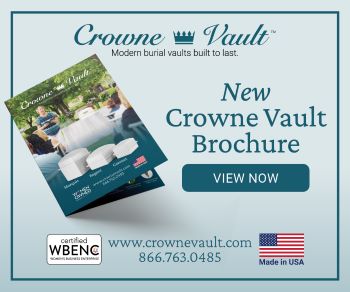Can Preneed lead funeral homes forward

If you operate or work at a funeral home you know that there is a lot of change going on. . . . .Let’s see, there is less church membership leading to less church services. And, less church services seems to be leading to less traditional services going so far as to move to an almost faster than thought possible movement into direct cremation with no services. Finally, we all know that direct cremation with no services will lead to less revenue and harder to maintain profit margins.
We also know that funeral service has morphed itself with changes over the last century and a half to keep pace with the tide of consumer sentiment surrounding death and its care. Sometimes funeral service led the change, such as moving to “funeral homes” from “home funerals” and sometimes the consumer led the change — moving from traditional earth burials to a preference for cremation over the years.
Thinking of change and a vision that may be needed for the next movement of funeral service I thought of former Massachusetts Senator Ted Kennedy and the eulogy at the funeral for his brother, Robert, back in 1968. Sen. Kennedy used this quote from his recently deceased brother to describe him at the funeral:
“Some men see things as they are and say why. I dream things that never were and say why not.”

Tom Anderson
Funeral Director Daily
I’m an entrepreneur by nature and I get a lot of ideas. . . . some are good, some are not so good. However, until they are vetted I say “Why not” and consider them possible with at least some idea of success if implemented. I once had an idea for a minor league of basketball in the early 1990’s, found investors and put it together beginning in 1995. Our group began a discussion with the NBA and I can connect the dots for you on how it led to the creation of the NBA’s G League in 2001. . . . As a matter of fact, I can connect existing teams in the “G” League historically with teams from our league — The International Basketball Association. (IBA Wikipedia -This history is not totally correct, but does give the IBA some relevance — from this entry, I know not everything on Wikipedia is totally correct!)
I’ve also served as a board member for six years and chairman for three years of a large Senior Living company as well as a board member for about ten years and five years as Board Chair of a home health and hospice company. Seeing the changes in those “late-in-life” consumer businesses has helped me look at a somewhat unusual idea for preneed and a potential new area of what I call “End-of-Life” planning as an extension of an existing funeral home.
If we look at the change in nursing home care — it is as stark as the change in death care moving from traditional funerals to direct cremation. In 1980 the average stay of someone who entered a nursing home was 398 days — that’s over 13 months and in today’s world at a cost of $10,000 per month a total cost of over $130,000 to the consumer or whomever is paying the bill. Today, 88% of nursing home stays are three months or less and only 6% of stays are one year or longer. That’s why, from a revenue standpoint that nursing homes also had to change and many moved into independent senior living as well as home care and hospice.
I see funeral homes somewhat at the same cross-roads now. Visioning out into the future, you can imagine a time when lower revenues may not support high fixed-cost business models such as traditional funeral homes. If that is the case, to stay viable a traditional funeral home needs to either increase their offerings to raise more revenue or decrease expenses to live within their means.
So, in my Sen. Robert Kennedy moment and “Dreaming things that never were and say why not?”, Why not have a funeral home enter the “End-of-Life” planning business?
Who in your community is meeting with consumers telling them of how and what they need to know about senior living environments, home care, funeral expenses, and “End-of-Life” or “Death Wish” financial situations? And, who has better credibility and trust in the community than the family-owned funeral home that has served the community for generations?
At one point over the past couple of decades Long-term care insurance was in vogue simply because of how it could save one’s estate from paying the long-term costs of a long nursing home stay. I might argue that it has went out of vogue and popularity in part because long-term care is not so “long-term” anymore. . . . evidenced by the cost of three months in a nursing home versus 13-months in a nursing home. That’s been driven down partly because of our ability to make “stay at home” living more comfortable for seniors via livability standards, the availability of lower cost home health care, and technology.
I also believe that there has been a change in philosophy among people in our nation and there is now a place for “Death Wish” insurance replacing “Long-term care” insurance.
“Death-wish” insurance is, in my opinion, a relatively new phenomena whereby there is a certain group of people who want to be benevolent and pass on some type of gift to those who follow behind them. It could be an insurance policy that would fund a niece or nephew’s college education or it could be an insurance policy that would fund a gift to their local animal shelter. The ideas for beneficiaries of “Death Wish” insurance are virtually endless.
In essence, as citizens of our nation live in bigger and bigger communities and our lives become more anonymous, I have sensed a feeling that people want to somehow make a difference to someone or something in their community. . . . and an insurance policy to fund that upon death is one way to do so.
It would be great if preneed companies could look at putting out larger policies that could be sold by funeral homes as part of a new “End-of-Life” planning services to consumers. Policies could be designed to cover both death care expenses, possible short-term limited nursing home care expenses, and then leave a death wish amount to be passed on to the cause of the insured’s choice. Policies could be designed to be 10-year pay or even more in order to be able to do so.
Larger policies could bring larger commissions to funeral homes and their agents. . . .it’s not a complete panacea to decreasing revenues, but it is an “out-of-the-box” idea that may have some success.
For the preneed companies larger policies increase the cash coming into the company which with proper actuarial charges, capped coverages, greater reserve investment balances for growth, and the potential for more lapses of policies over a ten or greater year premium schedule, should allow for higher profits to these companies.
It’s not so far-fetched that funeral homes could be the component to get consumers to move this way. . . .There is an insurance company in Great Britain that I have written about before that is doing just that. . . . check out Dead Happy here.
Sen. Robert Kennedy said it, but I believe it and dream it also. . . . . ““Some men see things as they are and say why. I dream things that never were and say why not.”
Related — “Those he touched”: Ted Kennedy’s heartbreaking eulogy for his slain brother, Bobby. The Washington Post
Related — Funeral Service Re-imagining Itself. While I was in the process of writing this article I saw a recent blog post from my friend Alan Creedy. . . While not insurance related, he also sees a need for funeral service to re-imagine itself.
Related — A cautionary tale of nursing home industry closings. Rising costs and declining workforce. Could this happen to traditional funeral homes? Article from the Minneapolis Star Tribune (MN)
More news from the world of Death Care:
- For 156 years, Lindquist morticians have looked forward. Deseret News (UT)
- Two iconic businesses said goodbye to Greenwich Avenue in 2023. Greenwich Times (CT)
- Mortician reveals what her job really involves. The Sun (Australia)
- As he exits Oakwood, Tim Baxter reflects on time well spent at the cemetery. Niagara Gazette (NY)
Enter your e-mail below to join the 3,442 others who receive Funeral Director Daily articles daily:
“A servant’s attitude guided by Christ leads to a significant life”





















